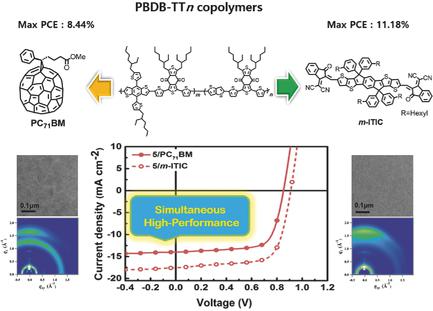当前位置:
X-MOL 学术
›
Adv. Energy Mater.
›
论文详情
Our official English website, www.x-mol.net, welcomes your
feedback! (Note: you will need to create a separate account there.)
Feasible D1–A–D2–A Random Copolymers for Simultaneous High‐Performance Fullerene and Nonfullerene Solar Cells
Advanced Energy Materials ( IF 24.4 ) Pub Date : 2017-11-16 , DOI: 10.1002/aenm.201702166 Mingyu Jeong 1 , Shanshan Chen 1 , Sang Myeon Lee 1 , Zhiwei Wang 2 , Yankang Yang 3 , Zhi-Guo Zhang 3 , Chunfeng Zhang 2 , Min Xiao 2 , Yongfang Li 3 , Changduk Yang 1
Advanced Energy Materials ( IF 24.4 ) Pub Date : 2017-11-16 , DOI: 10.1002/aenm.201702166 Mingyu Jeong 1 , Shanshan Chen 1 , Sang Myeon Lee 1 , Zhiwei Wang 2 , Yankang Yang 3 , Zhi-Guo Zhang 3 , Chunfeng Zhang 2 , Min Xiao 2 , Yongfang Li 3 , Changduk Yang 1
Affiliation

|
A series of PBDB‐TTn random donor copolymers is synthesized, consisting of an electron‐deficient benzo[1,2‐c:4,5‐c′]dithiophene‐4,8‐dione (BDD) unit and different ratios of two electron‐rich benzo[1,2‐b:4,5‐b′]dithiophene (BDT) and thieno[3,2‐b]thiophene (TT) units, with intention to modulate the intrachain and/or interchain interactions and ultimately bulk‐heterojunction morphology evolution. A comparative study using 4 × 2 polymer solar cell (PSC) performance maps and each of the [6,6]‐phenyl‐C71‐butyric acid methyl ester (PC71BM) and the fused‐aromatic‐ring‐based molecule (m‐ITIC) acceptors are carried out. Given the similarities in their absorption ranges and energy levels, the PBDB‐TTn copolymers clearly reveal a change in the absorption coefficients upon optimization of the BDT to TT ratio in the backbone. Among the given acceptor combination sets, superior performances are observed in the case of PBDB‐TT5 blended with PC71BM (8.34 ± 0.10%) or m‐ITIC (11.10 ± 0.08%), and the dominant factors causing power conversion efficiency differences in them are found to be distinctly different. For example, the performances of PC71BM‐based PSCs are governed by size and population of face‐on crystallites, while intermixed morphology without the formation of large phase‐separated aggregates is the key factor for achieving high‐performance m‐ITIC‐based PSCs. This study presents a new sketch of structure–morphology–performance relationships for fullerene‐ versus nonfullerene‐based PSCs.
中文翻译:

同时生产高性能富勒烯和非富勒烯太阳能电池的可行D1-A-D2-A无规共聚物
合成了一系列PBDB-TT n无规供体共聚物,由一个缺电子的苯并[1,2- c:4,5- c ']二噻吩-4,8-二酮(BDD)单元和两种不同的比率组成富电子苯并[1,2-b:4,5- b ']二噻吩(BDT)和噻吩并[3,2- b ]噻吩(TT)单元,与打算调制链内和/或链间的相互作用,并最终体-异质结形态演化。使用4×2聚合物太阳能电池(PSC)性能图以及[6,6]-苯基-C 71-丁酸甲酯(PC 71 BM)和基于稠合芳环的分子(米‐ITIC)受体已完成。鉴于它们的吸收范围和能级相似,PBDB-TT n共聚物在优化主链中BDT与TT的比例时,清楚地揭示了吸收系数的变化。在给定的受体组合组中,PBDB-TT5与PC 71 BM(8.34±0.10%)或m- ITIC(11.10±0.08%)混合时,观察到了优异的性能,并且是导致功率转换效率差异的主要因素。发现它们明显不同。例如,PC 71的性能基于BM的PSC受表面晶粒的大小和数量控制,而没有形成大的相分离聚集体的混合形态是获得高性能基于m -ITIC的PSC的关键因素。这项研究提出了基于富勒烯和非富勒烯的PSC的结构-形态-性能关系的新概图。
更新日期:2017-11-16
中文翻译:

同时生产高性能富勒烯和非富勒烯太阳能电池的可行D1-A-D2-A无规共聚物
合成了一系列PBDB-TT n无规供体共聚物,由一个缺电子的苯并[1,2- c:4,5- c ']二噻吩-4,8-二酮(BDD)单元和两种不同的比率组成富电子苯并[1,2-b:4,5- b ']二噻吩(BDT)和噻吩并[3,2- b ]噻吩(TT)单元,与打算调制链内和/或链间的相互作用,并最终体-异质结形态演化。使用4×2聚合物太阳能电池(PSC)性能图以及[6,6]-苯基-C 71-丁酸甲酯(PC 71 BM)和基于稠合芳环的分子(米‐ITIC)受体已完成。鉴于它们的吸收范围和能级相似,PBDB-TT n共聚物在优化主链中BDT与TT的比例时,清楚地揭示了吸收系数的变化。在给定的受体组合组中,PBDB-TT5与PC 71 BM(8.34±0.10%)或m- ITIC(11.10±0.08%)混合时,观察到了优异的性能,并且是导致功率转换效率差异的主要因素。发现它们明显不同。例如,PC 71的性能基于BM的PSC受表面晶粒的大小和数量控制,而没有形成大的相分离聚集体的混合形态是获得高性能基于m -ITIC的PSC的关键因素。这项研究提出了基于富勒烯和非富勒烯的PSC的结构-形态-性能关系的新概图。











































 京公网安备 11010802027423号
京公网安备 11010802027423号